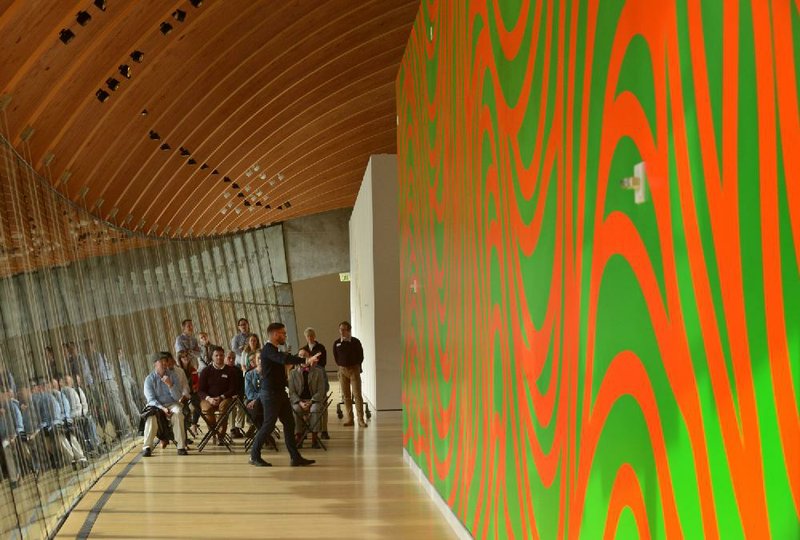BENTONVILLE -- The latest installation at Crystal Bridges Museum of American Art doesn't follow many traditional art characteristics.
It's not a canvas painting, sculpture or print, which can be found throughout the galleries of the Bentonville museum.
The work also took 34 days to install and, even more unusual, it was carried out by someone other than the artist.
Sol LeWitt's Wall Drawing 880: Loopy Doopy was completed based on a set of detailed instructions from the artist, who died in 2007, as part of his belief the true value of art was not in the object itself but in the idea. The emphasis led LeWitt to be one of the early leaders of the conceptual art movement, which began to make a cultural impact in the 1960s.
"LeWitt believed paintings aren't able to deliver any kind of feeling at all," Crystal Bridges curator Chad Alligood said. "They're just objects. Objects that could be bought and sold. Where is the core of artistic enterprise? It's not in the thing. It's in the idea. So Sol LeWitt decouples the idea from the art object. One of the ways is with these wall drawings."
The first of LeWitt's wall drawings was conceived in 1968, and the artist produced more than 1,200 throughout his life. Wall Drawing 880: Loopy Doopy made its debut on a 70-foot wall at PaceWildenstein Gallery in New York in 1998, and the work is exactly as it sounds: twisting waves of orange and green that can create a dizzying effect when viewed up close.
Crystal Bridges received the wall drawing -- or, at least, permission to create it on one of the outward-facing walls of the museum's early 20th-century gallery -- on loan from the Addison Gallery of American Art in Andover, Mass. The wall drawing at Crystal Bridges, which is about 17 feet high and 60 feet long and vibrant enough to be viewed from the bridge that houses Eleven Restaurant, will be on display for two years.
In keeping with LeWitt's belief that the idea was more important than the object itself, Wall Drawing 880: Loopy Doopy also is currently on display at the Massachusetts Museum of Contemporary Art as part of its retrospective on the artist's wall drawings. The retrospective includes 105 large-scale wall drawings that span his career from 1969-2007.
"Sol LeWitt loved that," Alligood said about Wall Drawing 880: Loopy Doopy existing in two places. "He encouraged the simultaneous showing of his wall drawings."
Crystal Bridges secured its loan from the Addison Gallery in May, which began a detailed and precise process that stretched most of five months and included planning, sketching and installing.
Victoria Perdomo, an assistant registrar at Crystal Bridges who worked on the installation, said it took about a month to get all of the contracts, requirements, materials and information pertaining to the work from the LeWitt Studio.
Perdomo said it also took months to find and secure the specific orange and green paint needed for the piece. The acrylic paint is only produced in Switzerland and there wasn't enough available in the United States, so larger quantities had to be ordered and imported.
Once all the materials arrived, two artists from the LeWitt Studio traveled to Bentonville to begin creating the piece, beginning with a sketch based on LeWitt's specific instructions. They worked with a four-person team from Crystal Bridges -- turning the white wall into a vibrant display.
"There's actually a very specific wall treatment that has to be done before you can even start painting, and it involves days and days of sanding and priming and sanding and priming," Perdomo said. "Then copious amounts of paper and tape that get put on layer after layer. Shapes are cut out, paint is applied. New shapes cut out. More paint applied.
"It's very repetitive in its process, but it is cumbersome to put together."
Perdomo said she has been involved in installations of LeWitt's wall drawings previously, but there was something unique about the project at Crystal Bridges. Even though the museum blocked off the portion of the gallery where the work was taking place, its progress was still visible through the large windows.
The finished result is what Alligood admits is a painting that can be "almost impossible to look at from a close range" because of its size and color. Still, Alligood believes its location in one of the outward-facing walls of the gallery is a perfect fit because of its visibility from afar and its proximity to the water that surrounds the gallery.
A reflection of those ripples appeared on the work while Alligood discussed it with museum visitors last week.
While Wall Drawing 880: Loopy Doopy is scheduled to be on display at the museum for two years, Alligood hinted that there's a possibility the loan could be extended further. Whenever it does end, saying goodbye to LeWitt's wall drawing will require another atypical process for a work of art.
"We just paint right over the wall," Alligood said. "But what happens at that moment? The work still exists. The idea continues to exist even if you can't see the painting in front of you anymore."
A Section on 11/28/2016

